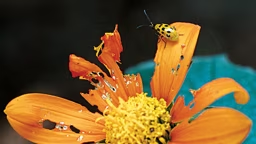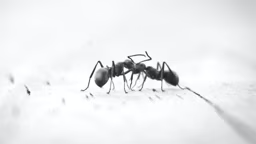Wasps or hornets can be a real nuisance—particularly when they build their nests in or around your home. Their stings are painful and may prove dangerous to those who are allergic. Below, you’ll find some easy steps you can take to keep wasps away.

"Yellow jacket" wasps have a long, shiny body with yellow and black stripes.
How to Tell the Difference Between Wasps and Bees
Wasps are easily distinguished from bees by their shiny appearance and narrow, dart-like body. A bee, on the other hand, has a round body and appears “fuzzy” thanks to the tiny hairs all over its body.Bees are, by nature, less aggressive than wasps when it comes to stinging. And while a bee can sting only once (its stinger will disembowel and kill the bee after), wasps can sting more than once. Wasp stings are particularly nasty, due to the barbed structure of the stinger.
What Type of Wasps Do You Have?
Your typical wasp will be yellow and black—these are most often referred to as “yellowjackets,” and are often mistaken for bees. Hornets—another type of wasp—are similarly-colored but have a larger body. Mud dauber wasps are dark-colored and have a longer, more slender body than wasps. Mud daubers are easy to identify due to the unusual-looking “pipe organ” design of their nests.

A mud dauber nest. Photo: Dana Schulz
Mud Daubers
Mud daubers attach their nests to overhanging structures, such as eaves or the corner of an awning. Their nests are constructed by collecting mud (hence the name) and building tube-like structures resembling pipes. These structures are then filled with various insect carcasses and a single egg before the wasps seal it up. The larvae will grow and feed on the insects inside the safety of the pipe until they are mature enough to emerge. Mud daubers tend to be more docile than other species of wasps but will still sting you if provoked.

Wasp nests have a paper-liked appearance.
Wasps
Wasps do not use mud to build their nests; instead, they use a combination of saliva and wood to build their intricate nests. These nests have a smooth, paper-like appearance, which is why they are sometimes called “paper wasps.” Unlike mud daubers, wasp larvae are actively cared for in these nests, thus making wasps more protective of their homes. Wasp nests are often found in a hole in the ground, but they will also build on low-hanging eaves, decks or other surfaces.

Hornet nests are larger and have an enclosed spherical design.
Hornets
Hornet nests are usually much larger than wasp nests and can contain more than 700 worker wasps . Hornet nests tend to be located off the ground in higher, less accessible places such as in tall trees or attached to chimneys. These large nests will have a smooth, spherical appearance with enclosed walls and a limited number of entries.
How to Get Rid of Wasps
Be careful! If you are going to tackle removing a wasp nest yourself, it is important to protect yourself from stings. Here are a few tips:
- Wear a long-sleeved shirt, long pants, gloves, eye protection, and some type of head covering.
- Do not approach the nest until you are ready to tackle wasp removal, and be sure you have a clear path of exit.
- Do not attempt to spray wasp nests during the daylight hours; wasps are less active in the early mornings and evenings, so plan on ambushing the nest during these times.
- Most sprays will make the wasps drop to the ground immediately. To avoid getting stung, do not stand directly below the nest when spraying.
- Do not break the nest during spraying. This will cause the wasps to scatter.
- Remove any pets, children or other non-essential adults from the vicinity before attempting wasp removal.
First Things First: Locate the Nest
The first step in getting rid of wasps is locating the nest. Check holes in your yard, underneath your deck, the corners of your shed, low-hanging eaves, remote corners of your garage, or any area that will accommodate the nest. For hornet nests, look at higher areas, such as tall trees or up on telephone poles.
Spray the Nest
You do not need to buy a commercial wasp and hornet spray to rid yourself of wasps. An effective and eco-friendly method of removing wasps is to spray the nest with a combination of dish soap and water. Fill your hose attachment with a mixture of water and approximately ½ cup of dish soap. The resulting mixture should be thin, but soapy. Spray the nest vigorously with this solution, making sure to cover all surfaces. Spray until the nest is soaked thoroughly, and there are no more signs of wasp activity.
Wasp nests located in holes in the ground can be treated with the same solution of water and dish soap. In this case, fill a large bucket with the solution and pour it all into the hole at once. The bucket can then be quickly placed upside down over the hole to trap any surviving wasps. This too,should be attempted in the early morning or evening when the wasps are less active.
Dusting
Once you have sprayed, you can apply an insecticide dust to the area. These dusts are formulated to deter wasps and hornets from returning to the nest and will kill any remaining wasps. Most insecticide dusts last around six months and should be re-applied until you are certain your wasp problem has been solved.

These festively colored glass wasp traps are from America's Gardens. Photo: courtesy America's Gardens
Wasp Traps
Even after all this, you may still find wasps buzzing around outside your home. They can be aggressive if there is food around, particularly anything with a lot of sugar. Wasp traps are designed to lure the wasps away from your food by offering them a sugary treat and then trapping them. You can easily make your own DIY wasp trap using a 2-liter bottle and a little soda. If you want something more decorative, you can buy colored glass wasp traps.
Did We Mention Be Careful?
Wasps can be a nuisance, but it is important to remember that they can also be dangerous. Some people are allergic to their stings and experience severe reactions including anaphylaxis, which is life-threatening. It is important to not shake or strike the nest aggressively in any way, and always follow proper safety precautions. If you find a wasp nest in a difficult-to-reach area, or one without a good escape path, you are better off consulting a professional.











